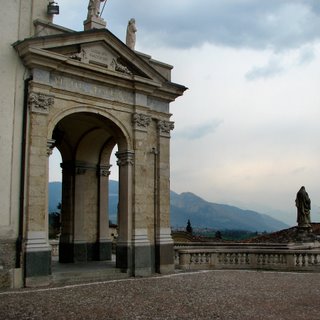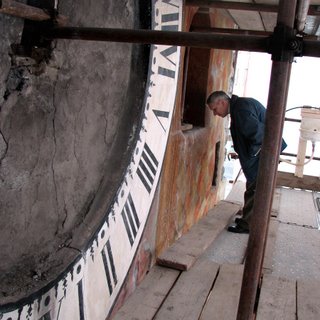
So what if it's six months too late... So what if it's June.. We finally found some snow! It started out as rain but by the time we went to sleep on Friday night in Zermatt, Switzerland it was snowing. And when we woke up on Saturday, there was a veritable winter wonderland splayed in front of our hotel room window. The pine trees covering the mountains were coated in white and the not-so-subtle cemetery beneath our window was rendered a little less eerie by the addition of fresh snow. We couldn't have been happier about the snow. Although there was one small problem - a little something we like to call the Matterhorn.
We came to Zermatt to see the Matterhorn - that giant alpine mountain known the world over as much for its dramatic profile as for inspiring a DisneyLand ride. But with all of the snow and clouds and general wintry-ness, the Matterhorn was nowhere to be seen. Really. It just wasn't there.

Zermatt is a cutesy Swiss town populated by chalets and tourists, and chalets for tourists. There are also vast quantities of cowbells and Swiss Army knives to be purchased. Only three hours from Milan, Zermatt sits in a picturesque valley surrounded by snow-covered Alps, alpine meadows and a most excellent view of the Matterhorn. It is, in fact, hard to find a postcard of Zermatt without the Matterhorn featured prominently.

On Saturday, we tried to see the Matterhorn up close. For the price of a nice hotel room in most countries (and the price of a nice hotel room + all of the contents of the mini bar in many others) we rode three cable cars into the white abyss. Often the slowly-rising car would emerge from the clouds and we'd see fierce mountain ranges below. It more closely resembled the view from an airplane than from earth. In the end, we were something like 12,000 feet up above Switzerland. My impressions at that altitude? White, white, and more white. And freezing.

It was so snowy at the top that the observation deck was partially closed. It had snowed so much the night before that they couldn't remove it all, and it didn't help that the snow blower was broken. We know the snow blower was broken because we saw it laying on its side in the snow as a man struggled to fix it. It was cold and pitiful... but then we took some photos with the snowblower. And the man fixing it. So then it was still cold but a touch more enjoyable.

Unfortunately, the glacier palace (which is touted as a highlight of the cable car adventure) was closed due to snow blocking the entrance. So, instead of seeing the Matterhorn, or the glacier palace, we took more photos in the complete whiteout. And when we finally came down from the mountain I stopped at the ticket booth to ask why no one had told us that the glacier palace was closed. The ticket agent told me, in all earnestness, that "when it is not open, it is closed." In one moment, Switzerland's reputation for precision and detail went out the snowy window.
We spent the rest of Saturday hiking and hunting the Matterhorn -- of which we finally caught a glimpse. We could see the tip - which was much higher up in the sky than we'd expected. Again, it's really hard to picture how gigantic the Matterhorn is until it's there in front of you. And here let me quote my favorite Swiss ticket agent: if it is not open, it is closed. And up until that point the Matterhorn was definitely closed.

Down in Zermatt most of the snow had melted by afternoon and our hike was gorgeous. We swept past alpine meadows thick with wildflowers. Waterfalls were streaming down the mountains. Disturbingly large snails crawled in the vegetation along the path and marmots took note of the coming dusk. There were deer skittering across the path, and soppy puddles to straddle. Some of us hadn't brought our hiking boots. And some of us also got sunburned. Ok, it was just me who didn't bring my hiking boots and then got sunburned. But I would like to note that I did remember the M&Ms and crackers.

Speaking of fine cuisine I should note that Switzerland makes a mean Raclette - which is basically vegetables served with melted cheese. While I don't question the savory combination of pickles and melted gruyere I do wonder how the Swiss can be such active hikers if they're eating melted cheese and pickles every night before bed. A worse state of affairs can be found in Swiss coffee. Apparently, Italians have long held the opinion that their neighbors to the north know nothing about coffee. And for once, I'll have to side with the Italians. Swiss coffee is nothing if not terrible. I have no idea how to make a great cappucino but if you'd like to have the opposite, order one in a Swiss hotel.
Our Sunday began by heading outside to see if the Matterhorn had decided to show itself. We joined hordes of other tourists waiting for a miracle. Most people gave up within a few minutes and took a picture with the clouds obscuring most of the famous peak, but we waited. And waited.

It wasn't until we were deep into our Sunday hike that the Matterhorn came blaring out of the clouds. And what an entrance... To have stared at a largely blank space in the horizon, with small cracks and hints at what was really there... And then to have the whole peak rising before you. It made you feel like a fool for ever having thought the average-sized peak nearby could have been the Matterhorn.
Our hike was picture-perfect. It had the kind of views you see in travel magazines - rolling green alpine meadows with white snow and flowers. Mountains everywhere. Small barns with stone slab roofs. Actual cows with cowbells. Sheep with cowbells. It was sunny and crisp and we just kept walking and wondering why we don't come to Switzerland more often.

There is something to be said about the cost of anything and everything in Switzerland. It's shockingly expensive for no identifiable reason. But we paid. Everyone pays. There's not much you can do. I guess when you have the Alps in your backyard you kind of have a monopoly on the Alps.
Unless they're closed. Because as we know from experience, if the Alps are not open, they are closed. At any price.













































